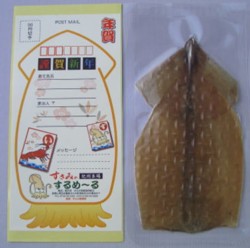scan blog
Do you know Malena? She was at SMCM before she transferred. Here is a blog she has where she scans some of her belongings: http://www.owningit.blogspot.com/
ART 214 at Saint Mary's College of Maryland with Fereshteh Toosi
Do you know Malena? She was at SMCM before she transferred. Here is a blog she has where she scans some of her belongings: http://www.owningit.blogspot.com/
I made a section to the right that will have links to some class documents.
The first one is for the postcard project info, in case you need to review it or you lost it since I distributed it in class.
Labels: handouts
Send them 15 stickers that you made (in Photoshop, perhaps?) and they will send you 15 stickers made by other artists from around the world: http://www.stickertraders.com/
 - edible squid postcard
- edible squid postcard
- old postcards for every taste: giants, cats, midgets, big potatoes, etc
- printable cold sores (technically not a postcard project but a good way to think about the possibilities for print media)
- boring postcards, mostly from Sweden
- Yiddish postcards
- vintage postcards from around the world
- motel postcards through the ages
- postcard art show in London with famous artists
- May, 1945 article from Popular Science tells the story of how American POWs in a Nazi prison camp were smuggled a custom Donald Duck logo prepared by the Walt Disney Studios on the back of a Red-Cross delivered postcard.
Labels: postcards
Tips on what I'm looking for in the postcard project:
Begin by doing brief research on the people to find out who they are, Wikipedia is a good start. Then, from that general overview, choose two who are interesting to you even if you didn't know them before. Then you will do some more in-depth research about the people, finding interesting details or information about their lives. You don't have to use their faces or portraits in the postcard, you could represent them with symbols or other objects that could be associated with them. Your viewer may not know who it's about right away, but you want to give them information or clues in a visual form. Use the assignment as a basis for the choice of images you use.
As for the relationship, imagine what it would be like if they met, or if they were penpals, or if they lived during the same time period, or if they were lovers or went on a trip together to outerspace. Think of them as characters that you will create a fiction with. Maybe one person travels from the future to the past, when one of the other people lived.
The photos you take on your own can be anything, but could be used as a background or other element of the vingette you are creating. Perhaps one of the characters goes sailing on Saint Mary's River, or we find Calvert alive again roaming historic Saint Mary's City or driving a car. So you would take a photo of the river, the city, or even a car.
Think also about how this is a postcard and how postcards function: often they represent a place, and are used by tourists for a souvenir or to write home. Take advantage of this form and remember that the 2 postcards are meant to be shown together. So perhaps one will not have full form or meaning without the other.
The scans due on Wed/Thurs will be the raw images you will use for your piece, so for example, I might scan a picture of a Paris because I discovered that one of my people used to live there, or a picture of a swimming pool because I want them to be there. So I will need to visit the library to find a good image of Paris to scan in, because Google is not allowed. And then I will use Photoshop to put their body in that background. Or maybe I scan my sweater because I think it might make a good texture for the sky in a scene I'm creating.. Bringing in your photos will count too.
Of course as with any project, some element of creative brainstorming with pen and pencil, doodles, and word lists is the first step. Do some initial research and I'm sure you'll start getting some ideas for interesting images and elements you could use. The sketches due on Mon/Tues are a start for your to know what elements you want in your final piece.
For more guidance about mail art, you have to look at the work of Ray Johnson, I've given some places for you to start below.
article on Ray Johnson
In the early ’60s, Johnson turned his back on convention and gave his art away to anyone who interested him, via something he called the New York Correspondence School. He set up the tongue-in-cheek institution, infuriating dealers and delighting the friends and acquaintances who received the works. By sending his pieces through the mail, he created an international network of collectors and shattered boundaries in the art world, meanwhile remaining its best-kept secret.
“Johnson formed a complex, ‘pre-digital’ creative network,” notes Donna De Salvo, curator for the Whitney show and curator at large at the Wexner Arts Center at Ohio State University. Indeed, before there was an Internet, there was “Mail art, ” an unorthodox movement, currently in its fourth decade, that hails Johnson as its “Grand-dada.”
“Johnson’s mail-away art can’t be bought or sold but only received,” the late critic David Bourdon once remarked.